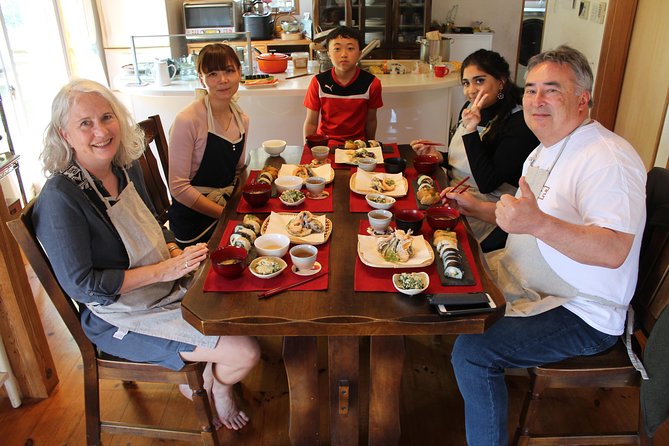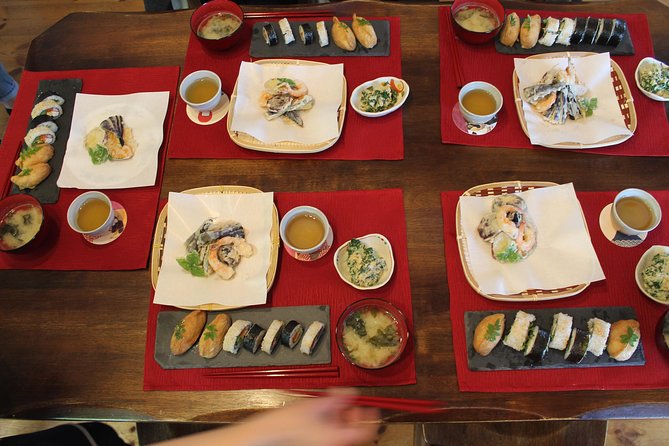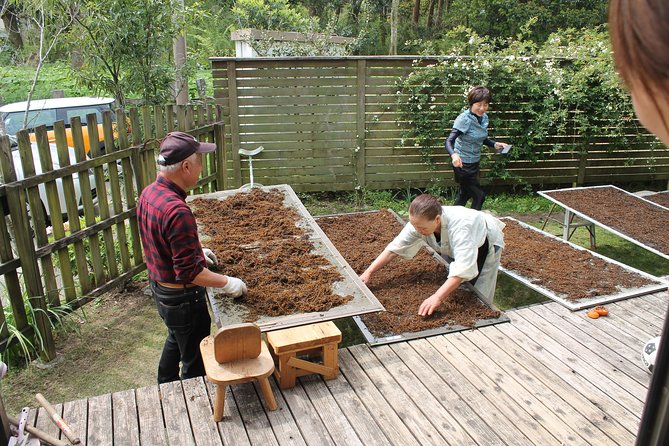Japanese Food Cooking at Home
Coincidentally stumbling upon a newfound interest in Japanese cuisine, one might find themselves intrigued by the idea of recreating authentic dishes within the confines of their own kitchen.
From the intricate art of sushi rolling to the sizzling delights of tempura, the world of Japanese food offers a vast array of flavors waiting to be explored.
With a few key ingredients and some essential tools, embarking on this culinary journey can be a rewarding experience.
But what exactly sets Japanese home cooking apart from dining out at a restaurant? Stay tuned to uncover the secrets to mastering the art of Japanese food preparation at home.
More food tours and experiences we've reviewed
More nearby cooking classses we've reviewed
Just The Basics

- Master traditional Japanese cooking techniques for authentic flavors at home.
- Use essential ingredients like soy sauce and miso paste for depth and balance.
- Present your dishes in traditional Japanese tableware for an enhanced dining experience.
- Embrace cultural influences of simplicity, balance, and respect for ingredients in your cooking.
Traditional Japanese Dishes to Cook
When cooking traditional Japanese dishes at home, one can explore a variety of options such as sushi, tempura, bento lunch boxes, gyoza, soups, and okonomiyaki. Japanese cooking techniques emphasize precision, balance, and showcasing the natural flavors of the ingredients.
Some popular Japanese ingredients used in these dishes include soy sauce, mirin, miso paste, dashi broth, rice vinegar, and nori seaweed. The art of Japanese cuisine often involves delicate knife skills, mastery of seasonings, and attention to detail in presentation.
To create authentic flavors, ingredients like fresh seafood, tender meats, seasonal vegetables, and high-quality rice are essential. Experimenting with these traditional dishes can be both a culinary adventure and a way to appreciate the rich culinary heritage of Japan.
Essential Ingredients and Tools

To create authentic Japanese dishes at home, essential ingredients like soy sauce, mirin, and miso paste, along with tools such as a sushi mat and sharp knives, are crucial for achieving traditional flavors and presentation. Stocking your Japanese pantry with these key items will ensure you’re well-equipped to prepare a variety of dishes such as sushi, tempura, and miso soup.
Soy sauce adds umami richness, mirin brings sweetness, and miso paste offers depth of flavor. Plus, cooking utensils like a rice cooker, bamboo steamer, and Japanese mortar and pestle are valuable for creating authentic Japanese meals. Having these tools on hand will make the cooking process smoother and more enjoyable, allowing you to explore the diverse flavors of Japanese cuisine at home.
Step-by-Step Cooking Instructions

Stocking your Japanese pantry with key ingredients and tools sets the foundation for mastering the step-by-step cooking instructions for authentic Japanese dishes at home.
-
Essential Knife Skills: Understanding how to slice, dice, and chop ingredients properly is crucial for Japanese cooking techniques.
-
Proper Rice Preparation: Perfecting the art of washing and cooking rice is essential for many Japanese dishes.
-
Meticulous Ingredient Measurement: Precision in measuring ingredients is vital for achieving authentic flavors.
-
Attention to Detail in Seasoning: Balancing flavors like soy sauce, mirin, and dashi is key in Japanese cooking.
-
Respect for Tradition: Following traditional methods preserves the cultural significance of Japanese cuisine while allowing room for fusion recipes and modern twists.
Tips for Authentic Flavors

For enhancing the authenticity of Japanese dishes, incorporating key ingredients like miso paste and bonito flakes is paramount to achieving rich and complex flavors. These ingredients are foundational in Japanese cuisine and offer unique umami profiles.
When preparing Japanese dishes at home, using traditional cooking techniques such as dashi stock-making and marinating with soy sauce can further elevate the flavor authenticity. Ingredient sourcing plays a crucial role in achieving genuine taste; opting for fresh, high-quality produce and authentic Japanese condiments can make a significant difference in the final dish.
Cultural influences heavily dictate the flavor profiles of Japanese food, emphasizing simplicity, balance, and respect for ingredients. By paying attention to these details, home cooks can successfully recreate the authentic flavors of Japan in their own kitchens.
Serving and Enjoying Your Creations

When ready to serve and savor your Japanese culinary creations, consider presenting them in traditional Japanese tableware to enhance the overall dining experience. Serving etiquette and cultural influences play important roles in the enjoyment of Japanese cuisine.
Here are some tips to make the most of your dining experience:
- Use chopsticks to eat traditional dishes like sushi and noodles.
- Serve miso soup in small bowls to be sipped directly from the bowl.
- Enjoy sake in small cups called ochoko for a traditional touch.
- Use soy sauce sparingly to enhance flavors without overpowering the dish.
- Embrace the Japanese custom of saying ‘Itadakimasu’ before starting your meal to show appreciation.
Frequently Asked Questions

Are There Any Specific Cultural Customs or Etiquette to Keep in Mind When Cooking Traditional Japanese Dishes at Home?
When cooking traditional Japanese dishes at home, individuals should be mindful of cultural customs and cooking techniques. Respecting the ingredients, mastering knife skills, and presenting dishes beautifully are essential elements in Japanese culinary tradition.
Can You Recommend Any Online Stores or Specialty Shops Where I Can Purchase Authentic Japanese Ingredients for Cooking at Home?
For authentic Japanese ingredients, one can explore online stores like Japan Centre, The Japanese Shop, or Marukai Market. These shops offer a variety of Japanese ingredient substitutes and cater to those interested in learning authentic Japanese cooking techniques at home.
How Can I Adapt Traditional Japanese Recipes to Accommodate Dietary Restrictions or Allergies?
When adapting traditional Japanese recipes for dietary restrictions or allergies, you can explore ingredient substitutions and alternative cooking techniques. Consider adjusting flavor profiles while maintaining authenticity, and focus on presentation tips to enhance the visual appeal of the dish.
Are There Any Lesser-Known, but Still Delicious, Japanese Dishes That I Can Try Cooking at Home?
Uncommon ingredients and unique flavor combinations can enhance the culinary experience. Exploring lesser-known Japanese dishes like Chawanmushi, Oyakodon, or Takoyaki offers a delightful journey into the rich tapestry of Japanese cuisine, perfect for home cooking adventures.
Can You Provide Recommendations for Pairing Japanese Dishes With Drinks, Such as Sake or Green Tea, to Enhance the Dining Experience at Home?
When considering Japanese dishes, pairing sake with sushi enhances the dining experience. For cocktail recipes, mixing sake with fruit juices creates a refreshing drink. Green tea varieties like Sencha or Matcha offer distinct flavors, with brewing tips focusing on water temperature and steeping time.
Final Words

To sum it up, cooking traditional Japanese dishes at home offers a delicious and immersive experience into the vibrant flavors and artful presentation of Japanese cuisine.
With expert guidance, essential ingredients, and step-by-step instructions, participants can hone their cooking skills and create authentic dishes like sushi, tempura, and gyoza.
This culinary adventure provides a cultural insight and a memorable way to enjoy a taste of Japan from the comfort of your own kitchen.
